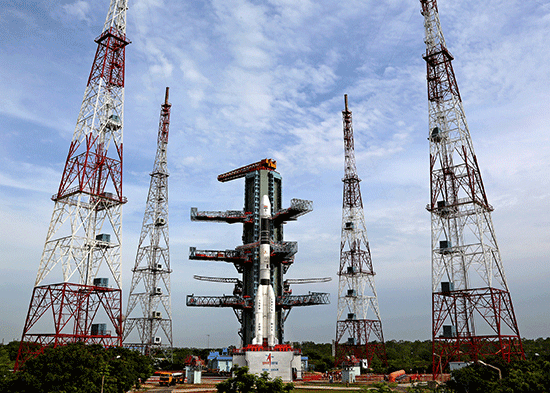
In a month marked by key advances in indigenously-developed technology, India's space agency will also test its mettle with a crucial rocket, powered by a cryogenic engine built in the country, slated to blast off Monday.
The countdown for the flight of the heavy geosynchronous satellite launch vehicle (GSLV) is set to begin Sunday evening, Indian space agency officials said.
According to Indian Space Research Organisation (ISRO), the 29 hour countdown would start at 11.50 a.m. Sunday and the rocket is expected to blast off at 4.50 p.m. Monday from India's rocket port Sriharikota in Andhra Pradesh, around 80 km from here.
This month has already seen key advances.
As the country celebrated its 67th Independence Day, the month saw activation of the indigenously built small reactor to power submarine INS Arihant, the launch of the indigenously-built aircraft carrier INS Vikrant while a unit of Kudankulam Nuclear Power Project (KNPP) is expected to be connected to the grid month end.
One event that created a shadow was the loss of Indian naval submarine INS Sindhurakshak.
Now eyes are on the ISRO to see whether the GSLV, powered by its own crucial cryogenic engine would successfully deliver its baby-communication satellite - the 1,982 kg GSAT-14 - into outer space.
"After two GSLV failures, ISRO has to prove itself at the earliest possible. There is always a pressure on that count," a senior ISRO official, who did not want to be named, told IANS.
This will be the first mission of GSLV during the last three years after two such rockets failed in 2010.
One of the GSLV rockets flew with Indian cryogenic engine and the other one with a Russian engine.
The GSLV is a three stage/engine rocket. The first stage is fired with solid fuel, the second is the liquid fuel and the third is the cryogenic engine.
The successful flight of this rocket is crucial for India as it will be the first step towards building rockets that can carry heavier payloads, up to four tons.
According to ISRO, several design changes have been incorporated in the Monday's rocket for a safe flight.
Design changes were made in the lower shroud/cover that protect the cryogenic engine during the atmospheric flight; wire tunnel of the cryogenic stage to withstand larger forces during the flight; and the revised aerodynamic characterisation of the entire rocket.
Others included video imaging of lower shroud movement during various flight phases; fuel booster in cryogenic engine; and ignition sequence of the cryogenic engine.
ISRO said indigenisation of many critical systems including liquid hydrogen propellant acquisition system (to prevent possibility of outside contamination) was achieved.
It is going to be a tense 17 minutes for the ISRO scientists Monday after the 49.13 metre tall rocket weighing 414.75 ton blasts off at 4.50 p.m. till the GSLV rocket safely delivers GSAT-14 to augment the Indian transponder - receivers and transmitters of signals - capacity.
ISRO is planning to launch an upgraded version of GSLV Mark III rocket next year with a dummy payload. The design payload capacity of GSLV Mark III is four tons.
Meanwhile an ISRO official said the fuelling of the three stage/engine GSLV rocket's four strap-on motors and the second stage with liquid fuel will be completed by Aug 19 morning while the first stage core engine is powered by solid fuel.
The process of fuelling the cryogenic engine will begin around 10 hours prior to the launch.